My letterpress project in September was a three-panel rendering of the lyrics to The Island Hymn, by Prince Edward Island author L.M. Montgomery. The song is, officially, “the patriotic song of Prince Edward Island.” Montgomery wrote it in 1907, and it was first performed, to the tune of God Save The King, on Arbor Day in 1907. The following year, with lyrics by Lawrence W. Watson, the hymn was first performed as we know it today.
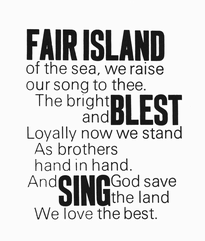 |
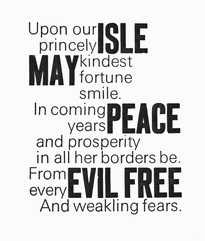 |
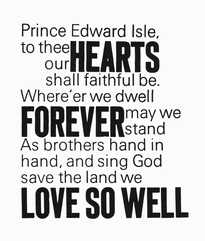 |
(Purchase the set of 3 from my shop if you’d like your own)
Each panel of my “triptych” of The Island Hymn is printed in black ink on a Golding Jobber No. 8 letterpress on a 5½ by 6½ inch piece of plain white card stock. The larger face is 60 point Akzidenz Grotesk and the smaller is Univers (both faces are type purchased used, this spring, from Atelier Domino).
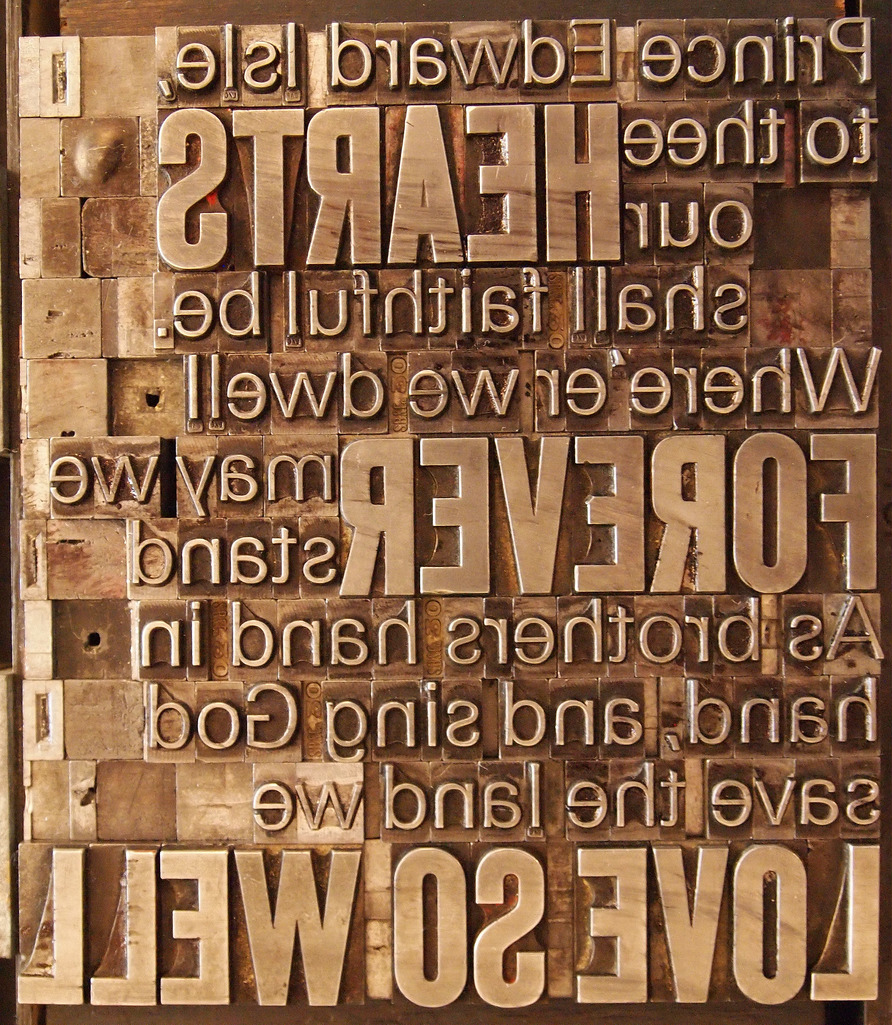 |
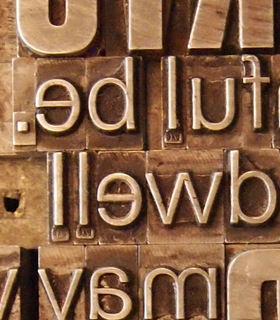 |
I presented a set to my friend Catherine Hennessey for her birthday this year, and in return she kindly gave me a copy of the lyrics and sheet music prepared by the 1973 Centennial Commission (1MB PDF).
I took the sheet music from that brochure, scanned it on my Doxie scanner and the scanned image through a demo copy of the SharpEye Music Scanner application for Windows which resulted in a MIDI file of The Island Hymn which I dragged into Garage Band. The result, after some fiddling, was that I could listen to the music as I was reading the lyrics I’d printed.
(There’s a bug in the 3rd bar in the bass line that I struggled and failed to correct — my musical knowledge has been slowing draining away since piano lessons ended 30 years ago — and I welcome a corrected version if you’ve got the MIDI chops to help me.)
There’s something magical about taking a 39 year old piece of sheet music of a 104 year old piece of music and, 20 minutes and some digital processing later, having it come out of your headphones.
If you want to hear a more rousing and real-world rendition of The Island Hymn, check out this YouTube video shot in Florida of vacationing Islanders singing their hearts out. If you look carefully you can see a former Premier of Prince Edward Island in the choir.
You don’t actually need ink to be able to “print” with a letterpress: thick paper, large, bold type and sufficient pressure will do. I’ve wanted to make a new sign for the office door here at the Reinventorium for a while; wanting to print this afternoon, but also wanting to avoid the hassle of cleaning up the press afterwards, I decided to see what I could create without ink.
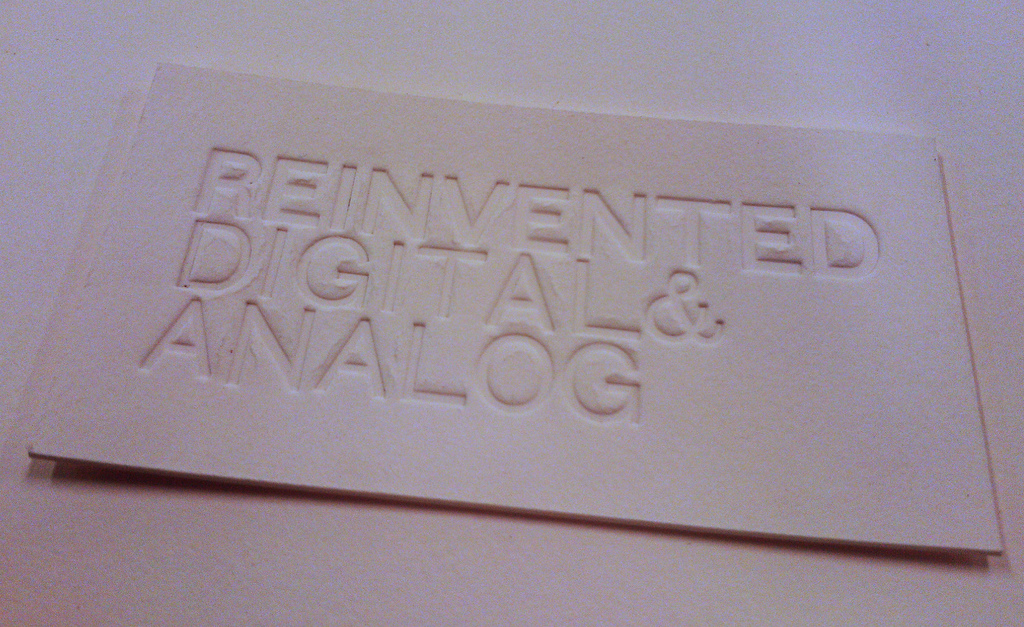
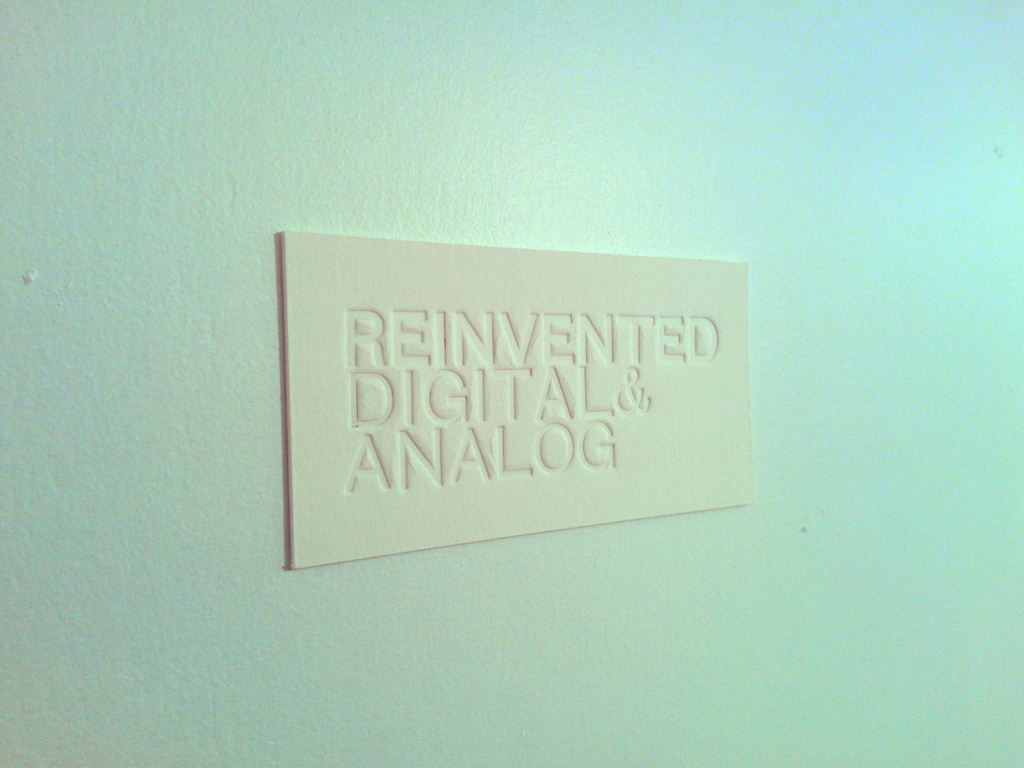
The paper is Crane Lettra 220 lb. in “ecru white.” The type is an unnamed 36 point all-caps face I purchased this spring from Atelier Domino in Montreal.
I actually created a little too much of an impression: if you look carefully you can see some “rupturing” around certain of the letters. Perhaps I should have used a little less packing, or moistened the stock a little before taking the impression. Nonetheless, I’m happy with the result, and it’s on the door to the office now.
The new Terre Rouge “bistro marché” opened in the old Carter’s building on Queen Street today. It’s a combination restaurant and high-end grocery store, connected, both physically and spiritually, to the olive oil shop next door. Oliver and I popped in for a look after lunch this afternoon; the place was packed.
I can’t imagine a place more different than the Clover Farm grocery store that preceded it in the space: the Clover Farm was targetted firmly at the “cheapest tin of peas” and “reduced meat” demographic; the new place is all chorizo, fancy cheese, crème fraîche, gelato and wines-by-the-glass. It’s like the place crossed over to the other side of the tracks without moving an inch.
Certainly the owners of the new place are to be lauded for their moxie, and for investing in what, ultimately, is a risky venture: I’ve always said there’s a huge gap between the aspiration for daily neighbourhood baguettes and the economic and practical reality of daily neighbourhood baguettes, and it’s in the filling in of that chasm that Terre Rouge will suceed or fail.
That all said, it would have been nice to end up with a more “workaday” grocery store in downtown Charlottetown. I’m not wishing for a return of the downmarket Clover Farm by any means, but surely somewhere between “past-expiry-date yoghurt” and “handcrafted pickled plums” lies the kind of grocery store that can actually serve our daily needs for a resonable price.
My jury is out on Terre Rouge for now: I wish them well, and perhaps they’ll do better than their predecessors at listening to their customers and adapting their product mix to cater to our actual day-to-day needs.
Twenty years ago last month, in the fall of 1992, my friends Richard and Victoria moved from Peterborough, Ontario to Halifax, Nova Scotia. I both owned a pickup truck and was unemployed at the time and so, always being game for an adventure, I offered to load up their life into the truck and, along with my friend Stephen Southall, make the trip east with them.
We had lovely weather for the journey. And Stephen is a great travel companion (to every hitchhiker we picked up, Stephen gave a different life story; “oh, I’m an accountant.” I think we may have inadvertently prevented a young lad from becoming and air traffic controller in the process).
We drove south into New York and across through Vermont and Maine, and crossed back into Canada at St. Stephen. At the border we presented quite a scene: a couple of beardy ruffians with a yappy dog, hauling a pickup truck filled with who-knows-what. The border guard asked Stephen, who was driving, to “please hold your dog,” which Stephen took to mean “please hold your dog up to me so I can pet it because it is so adorable.” This is not what the border guard meant.
Miraculously, though, we were let through with nary a question while Richard and Victoria, the clean-cut couple behind us driving a late model sedan, were held up for over an hour with questioning and searching.
In New Brunswick we took the dip down into Fundy National Park, during which time the brakes on my 1978 Ford F100 pickup started to die. They got as far as Halifax, fortunately, where Canadian Tire was able to bring them back to life.
Leaving Victoria and Richard to start their new life in Halifax, we headed west. When we got to the fork in the road just across the New Brunswick border — one direction Moncton, the other direction PEI — we flipped a coin. Prince Edward Island won. And we headed for the ferry. It was to be my first visit to the Island.
Coming off the ferry on the other end we pulled up to the Visitor Information Centre to get a map and our bearings. It was the off-season, however, so the Visitor Information Centre had been repurposed into a daycare (the liquor store next door was still open, though). So, with no bearings to be had, and no knowledge whatsoever of the Island, we turned west at the Albany Y and, before we knew what had happened, we hit West Point (after driving from Ontario to the east, the distance from Borden to West Point seems like popping round the corner).
We set up camp in Cedar Dunes Provincial Park for the night. I remember thinking “my, this place is really beautiful.”
The next morning, having driven as far west as we could imagine, we retraced our steps and headed toward Charlottetown. We set up camp at Strathgarney Provincial Park, and then, on a dark and stormy night, drove into town, or at least the edge of town, to catch a movie — it might have been Sneakers or perhaps School Ties; I can’t recall. We never actually made it into Charlottetown proper.
In the morning we packed up camp, headed for the ferry back to the mainland, and, as recounted earlier in these pages, drove back to Peterborough by way of Rhode Island.
Five months later I was back on Prince Edward Island for a job interview, and, a month after that, in the same pickup truck, this time loaded with my things and Catherine’s, I was a resident (Catherine came two months later). We’ve been here ever since.
A lucky happenstance — it was actually a bug on the website that needed some fixing — drew my attention to some long-forgotten audio recordings on Almanac.com, (the website of The Old Farmer’s Almanac that I’ve maintained for the past 17 years).
The monthly Garden Musings are short essays written by George and Becky Lohmiller, gardening exports from Hancock, New Hampshire. Since 2007, each essay has been recorded and posted on Almanac.com; before he died in 2008, my dear friend and colleague John Pierce was the narrator and fixing the bug I fixed today unearthed these old recordings on the web. They are among the last things John recorded before he died. It’s so good to hear his voice again:
The monthly Garden Musings are available as a podcast too; they’re not read by John any longer, of course, but a new crop of narrators has stepped in to the breach.
It was Architecture Week here in Charlottetown last week, and, alas, it was a week of merriment that passed me by entirely. Unlike last year, when I not only visited every architecture office of note in the city, but I gave them awards to boot.
My absence, I am happy to say, was noted by no less than three “where are you?” email messages from the architects of the city on Friday afternoon. Apparently I was a sizeable enough proportion of the open-house-visiting-public that urgent action was required. Or maybe there was simply fear that I was off giving awards to some other firm.
My disappearance from the wine-and-cheese-fuelled afternoon was, I hope, understandable: Friday also happened to be the 40th annivesary of no less than two of my brothers, and, as is the tradition in my family, this event was marked with an epic “fly everyone in from across the country” surprise party, for which my complicity services were required. (Friday was also my 21st anniversary with Catherine, something that got lost and overshadowed in the process).
It seems perhaps that the architects’ concerns were warranted, at least as regards shining a light on their profession: the Lieutenant Governor’s Award of Excellence in Architecture was given out on Thursday night at Government House and this event appears to have completely escaped the attention of media. Granted, it appears to have also escaped the attention of the Architects Association itself. So they have only themselves to blame. (Does anyone know who this year’s winner was?)
As almost all my heroes are either librarians or architects (if you’re a librarian at an architecture firm we should probably discuss marriage), I will endeavour to not schedule conflicting events for the 2013 celebration of the profession. Keep the wine chilling.
The summer I was 19 years old I bought myself a VIA rail pass, a frame backpack and sleeping back from Canadian Tire, and headed east. It was 1985 and I was looking for adventure. Or at least to get out of the house.
My first stop was Québec City.
After setting up camp at a small, cheap, only-mildly-sketchy hotel on the outer edge of the old city I went looking to buy a comb, the only vital personal care item I’d neglected to bring with me.
While I was equipped with 6 years of Ontario public school French, none of the vocabulary lessons I’d learned from Sol involved personal care items, so, lost in a pharmacy that had no combs in evidence, I was left to describe what I needed in more primitive terms.
“Avez vous un chose avec les petites batons pour écraser mon cheval?”
“Do you have a thing with little sticks to straighten my hair?”, I thought I was saying. I wasn’t.
But, somehow, I got a comb.
The next day I continued east to Moncton. I knew nothing about Moncton. But on the map it looked like it was close to the ocean, and I thought I might exercise my camping muscles by walking to the seaside.
The train arrived mid-morning. I stopped at the food court in the mall near the station for breakfast, and then headed out of town on foot.
I had no idea how I knew which way to go; I suppose I must have followed the signs for Shediac. I was entirely unprepared for walking the 30 kilometers ahead of me. I was wearing cheap old running shoes. I had no food or water. I’d never walked more than a mile or two before in one go.
But, like I said, I was looking for adventure.
After about 3 hours I’d escaped the suburbs of Moncton and was in rural New Brunswick. My feet hurt like hell. It was getting late. And I had no choice but to continue.
I kept walking. And walking. And walking.
In the late afternoon I was pretty close to not being able to walk any more: I had blisters on both feet, was dehydrated, and I had little idea how far it was to the sea.
So I decided, having really no other choice, to hitchhike to Shediac. I’d never hitchhiked before. It had never occured to me to hitchhike before: I’d never had anywhere I needed to go that I couldn’t get otherwise.
It was surprisingly easy: I stuck my thumb out, and the first car that came along picked me up. Ten minutes we arrived in Shediac.
I’m not sure what was going on in Shediac that late summer night, but there turned out not to be a hotel room or a campsite available. Not a single one. I walked (hobbled) from one end of town to the other. Nothing.
It was getting late — it seemed like midnight but I expect it was around eight — and so, in desparation, I headed off into the forest, just across the road from the RCMP detachment (perhaps I figured I’d be safe?). I didn’t have a tent, but I had a plastic sheet. And plenty of branches. So I set up camp as best I could, tucked into my sleeping back, and fell almost immediately to sleep.
Until I was woken up by what, at the time, sounded to me a lot like a bear. It probably wasn’t a bear. It might have been a squirrel, or a raccoon, or a fox. But whatever it was, I couldn’t see it, it was breathing really loudly, and I was terrified. In a panic I tore down camp and stuffed everything into the Canadian Tire frame backpack and ran out to the highway.
Where I stuck out my thumb. Toward Moncton. I was getting the hell out of Shediac.
Again, hitchhiking proved quite easy: a truck picked me up after about 5 minutes. Nice guy. Told me where I might be able to get a room in Moncton, and drove me right downtown, out of his way.
I spent a very (very) pleasant rest-of-the-night, no creatures in sight, in a room at the Colonial Inn — it’s still there — just 450 m from where I’d started the day 12 hours earlier at the train station.
The rest of my trip was much less eventful: the next day I took the train to Halifax, found a summer residence room at Dalhousie University, and hobbled around the city on my blistery feet for 3 days. I saw the The Man with One Red Shoe at the Paramount. Went to the public library. Saw a bit of the city.
And then, after 6 days on road, I got back on the train and headed back west to Ontario.
Tim Chaisson first appeared on my radar in an episode of Steven Garrity’s Acts of Volition Radio 8 years ago. He was Timothy back then — his old timothychaisson.com domain seems to be a Japanese motorcycle site now — and only 17 years old. Steven played a track, Stay, from Tim’s “Something Acoustic” album and called him “the beginning of a really great songwriter.” He was right.
Tim’s the kind of young hipster who plays the kind of clubs that start up after my bedtime, so I’m left to catch his band dates like the bandshell in Souris (which is, don’t get me wrong, a pretty good place to see any Chaisson). I somewhat famously predicted, 5 years ago, that “the Timothy Chaisson song all over again will be used as closing credits power ballad on a prime-time television U.S. program in the next 12 months”, a prophecy that came (sort of) true 3 years later.
I really, really like the kind of impromptu videos that Tim’s made over the years — like this one in Toronto and this one at UPEI. And he played a lovely acoustic set at Zap Your PRAM, five years ago this month.
Which is, all to say, in the intervening years I’ve become a big fan myself. And so why the appearance of new album by Tim is a Big Deal. I’ve been listening to The Other Side, released just a few weeks ago, all day. I can’t stop: it’s a great piece of varied work, pop built on a bedrock of east coast traditional. From Long Road of Love (backstory):
Caught a teardrop from the sky.
You’re the saddest girl on PEI.
You should never love another guy.
But you’ll never know if you never try.
You can watch a track-by-track commentary on each song on the album on Tim’s YouTube channel. Which is where you’ll also find this video, feature Serena Ryder, for the track Beat This Heart:
You can buy The Other Side where quality albums are sold, including iTunes and from Tim’s label. You’ll be happy you did.
My great-great-grandfather, Nathaniel Caswell, was born, the first of 11 children, in 1835 in Innisville, Ontario. He died, 97 years later, in 1932, in Cobden. Here he is in 1925, at age 90, sitting atop the roof of a house he built himself:
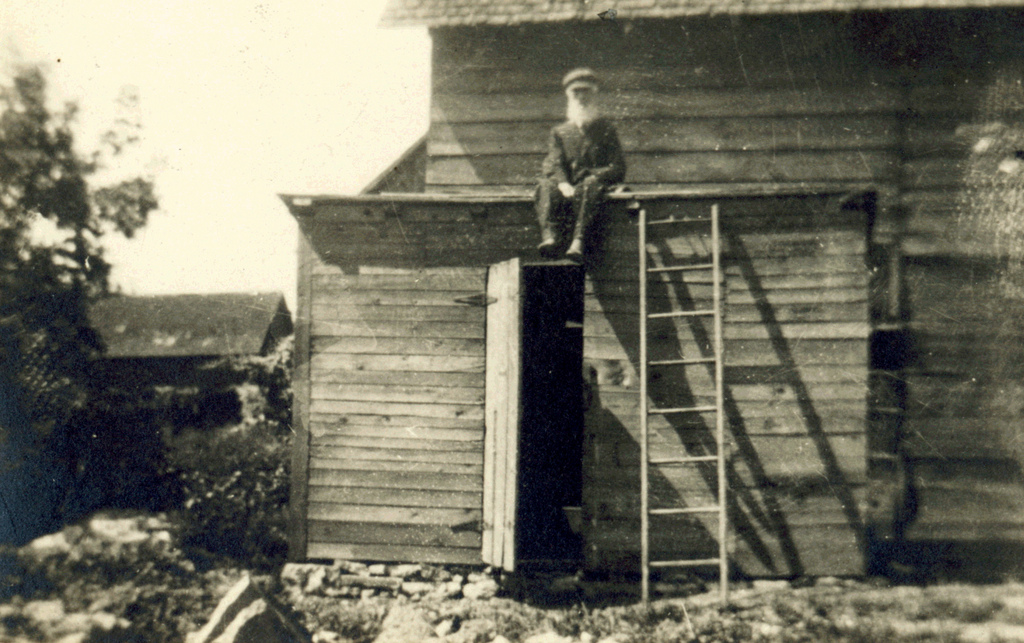
In Our Caswell Relatives he’s described as a “man of high intelligence [and] an omnivorous reader [who] being gifted with unusual eyesight, could read without the aid of spectacles” and as someone who could “pass for having a much better education than he had ever received.” His grandson, Dr. Robert L. Jones, recalls:
Nathaniel Caswell appears to have been very much respected as a citizen. He was notable for his easy-going nature and his tolerance of the opinions of others. He never got excited over things which were none of his business. He was a lifelong Conservative (except for one occasion when he voted for a candidate of the United Farmers of Ontario, a deviation which he always subsequently regretted). My father, who considered this to be a compliment, not a disparagement, said of him that he lived so long and with so little illness because he never killed himself working.
At the age of 92 he composed an autobiographical poem:
In 1835 I was born on a small piece of earth
In a log house nine miles from Perth.
My father and mother watched over my youth
And taught me respect for religion and truth.My brothers and sisters joined in my play,
And helped me enjoy the sports of the day.
My partner in life was loving and true;
It was sad when the time came she had to depart.
The hope of the Christian still rules my heart.My sons and my daughters I also must say
Are thoughtful and kind when I am old and grey.
I never was rich but always had good hash
A small share of brains, often scarce of cash.And yet I have friends I’d like to greet
But if on earth we never meet
We all may come in love complete
And join around the Mercy Seat.
And when our earthly sands are run
If we the great reward have won,
We then may tune our voice and sing
With Him who washed us in the blood
And made us kings and priests with God.If any should ask you who do you think I am
You may answer and say,
‘It shure must be Than.’
If I’m still dangling my legs from the side of a shed and writing poetry when I’m in my 90s, I’ll count myself lucky.
Oliver Duncan Lowell Rukavina turned 12 years old yesterday. We celebrated with breakfast the day before with uncle, aunt and cousins, and then, last night at supper, with a sushi supper with friends new and old.
One of the things about Oliver is that he doesn’t do anything halfway: he either does it, or he doesn’t do it, and the transitions between one state and other more “blamo” than “gentle evolution.”
This has been true of many things — sitting up, crawling, walking, Googling — and it was true of being born too. Oliver, after two days of unconscious teetering on the edge of life, just, one morning, turned on as a healthy, full-formed, fully present little kid:
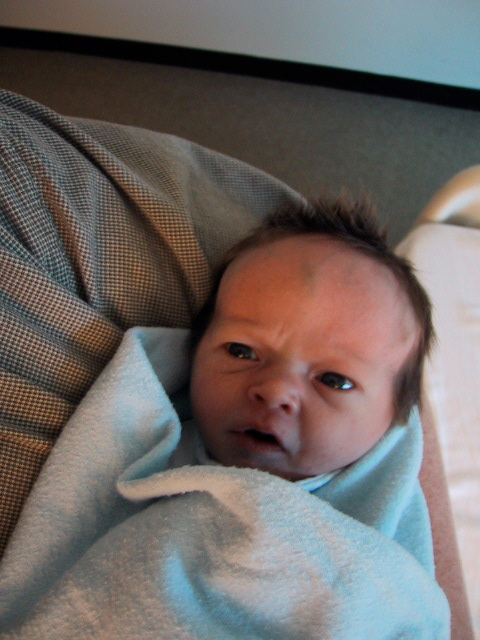
That was, by coincidence, the day he got his name, meaning the nurses could stop calling him “Baby Male Miller.”
Raising Oliver with Catherine is a tremendous joy; I can’t imagine my life without either of them. Happy Birthday, Oliver.
 I am
I am